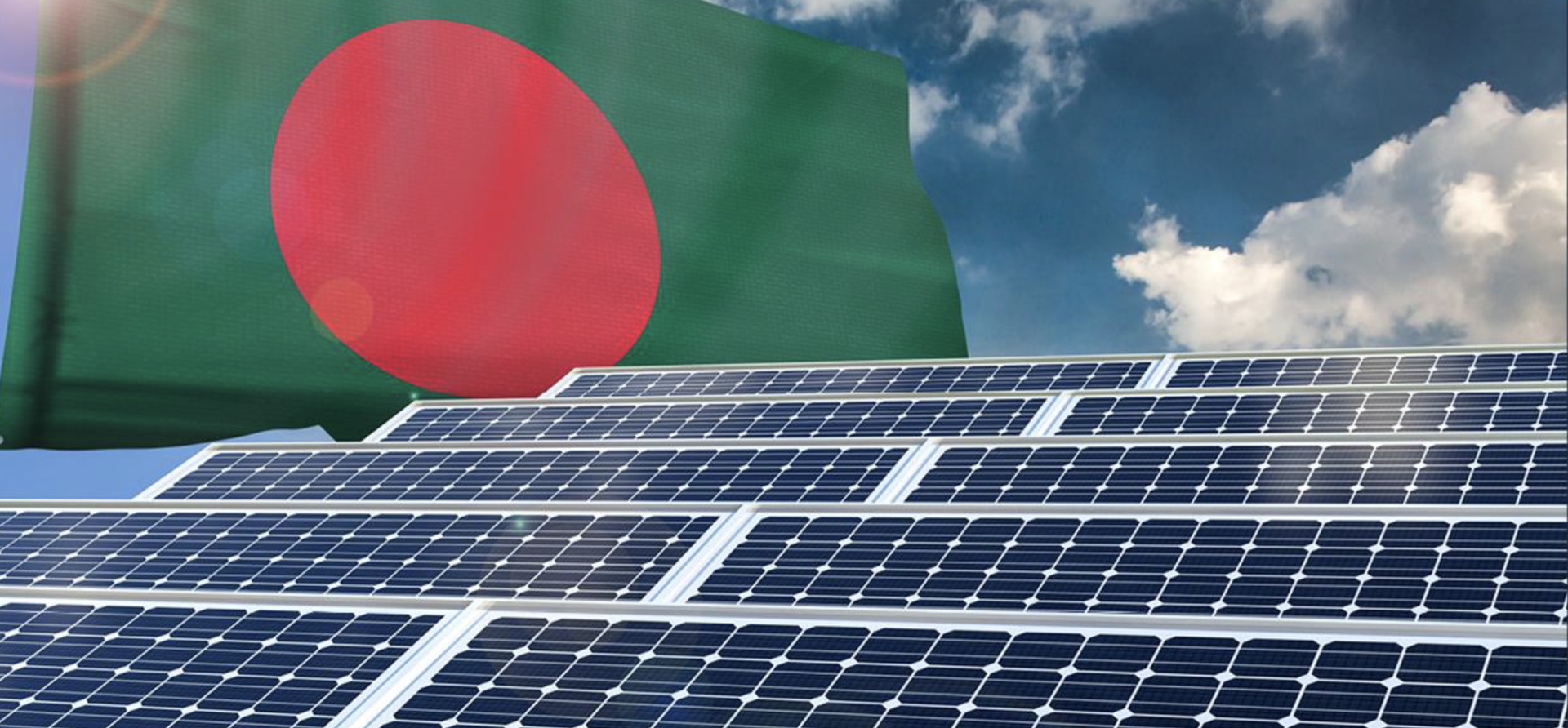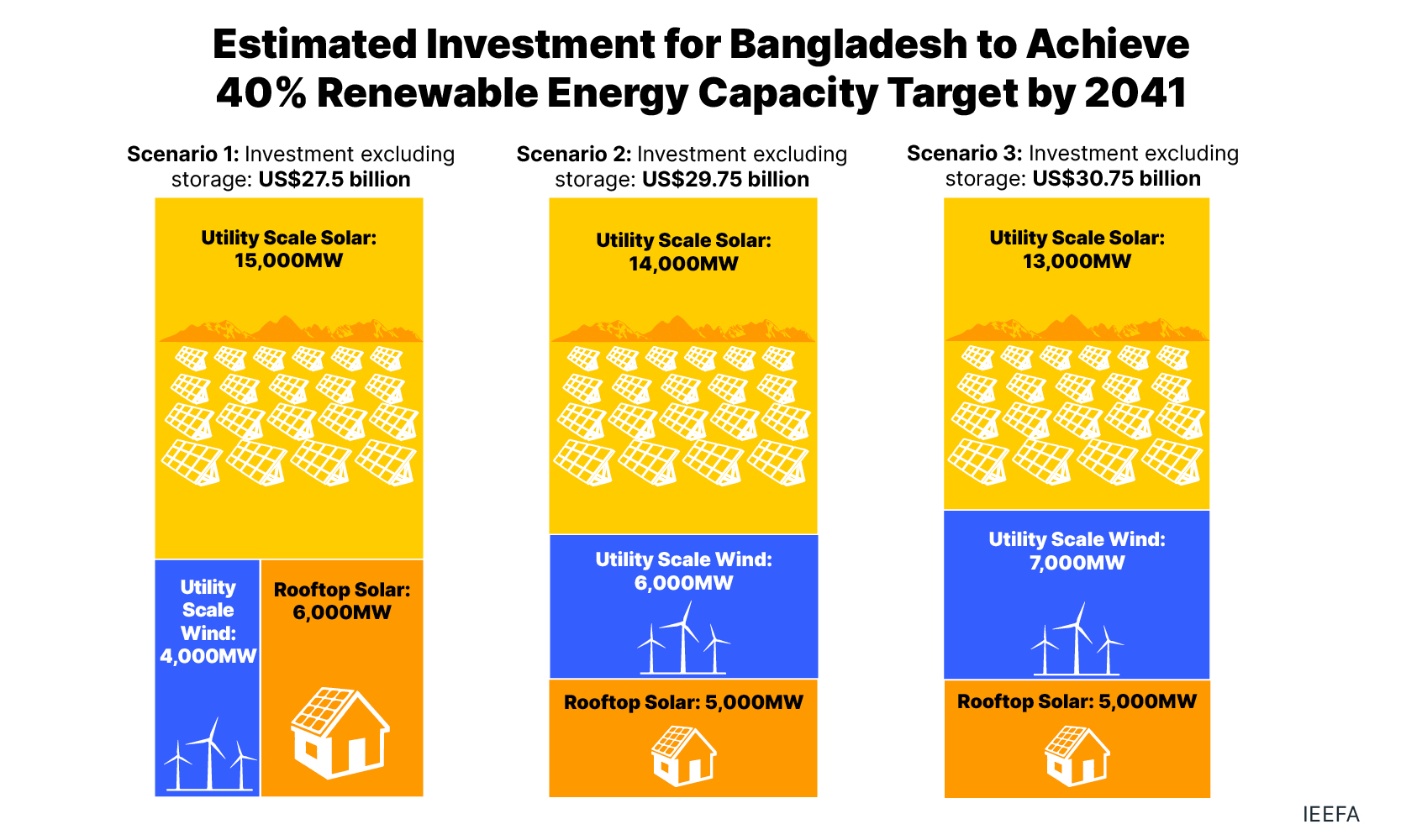Charting an electricity sector transition pathway for Bangladesh
Download Full Report
View Press Release

Key Findings
Bangladesh’s existing power system can incorporate 1,700 megawatts (MW) to 3,400MW of solar power during the day and, subject to technical and economic feasibility, 2,500-4,000MW of wind power at night to reduce the use of costly oil-based electricity.
The annual investment required for enhancing renewable energy capacity to 40% of Bangladesh’s power generation capacity by 2041 is lower than the power sector’s FY2021-22 subsidy burden of US$2.82 billion.
Average electricity generation cost will likely cross double-digits in Bangladeshi Taka (Tk) terms in FY2022-23.
Ballpark estimates show that the levelised cost of electricity (LCOE) from rooftop and utility-scale solar is around Tk5.25/kilowatt-hour (kWh) (US$0.05/kWh) and Tk7.6/kWh (US$0.072/kWh), respectively.
Renewable energy capacity addition is the most favourable option for Bangladesh’s power system, which suffers from a hefty subsidy burden and overdependence on imported fossil fuels. The Bangladesh government should enhance renewable energy ambition to achieve a higher target like 40% renewable energy capacity by 2041 and reflect the same in the upcoming Integrated Energy and Power Master Plan (IEPMP). It should also set a year-wise action plan backed by a monitoring mechanism to track progress. By our estimates, Bangladesh needs between US$1.53 billion and US$1.71 billion of annual investment from 2024 through 2041, not including the cost of grid modernisation and storage facilities, to meet such a target. This figure is less than the subsidy burden of the power sector in the fiscal year 2021-22. Not only does the country need a plan to mobilise such level of investments from various channels, but the government also needs to take several policy measures to send the right signals to the market about Bangladesh’s electricity transition goals.
Bangladesh’s grid-based electricity generation capacity increased rapidly from 5,493 megawatts (MW) to 23,482MW over the last 14 years (from 2009 to January 2023). The need for quickly ramping up generation capacity to fill the demand-supply gap and minimise load-shedding prompted the government to resort to imported fossil fuels-based generation, since 2009, amid dwindling local gas supply. The flip side is that the growing reliance on imported fossil fuels will limit the space for renewable energy development.
The power sector of Bangladesh is also grappling with colossal subsidy burdens. For instance, high prices of fossil fuels and increased power generation costs led to a subsidy burden of Bangladeshi Taka (Tk) 297 billion (US$2.82 billion) during the fiscal year (FY) 2021-22, a steep rise of 152% from FY2020-21 and a whopping leap of 301% from FY2019-20.
The burgeoning pressure of fossil fuel imports eventually compels the government to pass the rising cost on to consumers. This results in a spectre of price hikes for electricity and different fuels in quick succession. Despite these price hikes, the subsidy burden of the power sector in FY2022-23 could still surpass the Tk297 billion (US$2.82 billion) recorded in FY2021-22.

Source: IEEFA
The strained power sector indicates that Bangladesh’s electricity generation model appears unsustainable. Increasingly competitive renewable energy capacity addition is more favourable for Bangladesh. However, without a clear transition pathway, the fossil fuels-driven electricity generation system will likely stay for the foreseeable future.
There have been some policy lapses in the past. For example, the renewable energy policy of 2008 could not stimulate the uptake of clean energy at the desired level. Further, the Power System Master Plans (PSMP) of 2010 and 2016 primarily focused on imported fossil fuels, such as coal and liquefied natural gas (LNG).
Now, there are some encouraging signs that utility-scale solar and wind projects are gaining traction. Besides, ballpark estimates show that the levelised cost of electricity (LCOE) from rooftop and utility-scale solar is around Tk5.25/kilowatt-hour (kWh) (US$0.05/kWh) and Tk7.6/kWh (US$0.072/kWh), respectively. This is at a time when the average electricity generation cost of the Bangladesh Power Development Board (BPDB) was Tk8.84/kWh (US$0.084/kWh) during FY2021-22. Notably, the average electricity generation cost will likely cross double-digits in Tk during FY2022-23.
The electricity sector transition to renewable energy would free up financial resources, which otherwise end up as subsidy payments, and enhance the country’s energy security.
The electricity sector transition to renewable energy would free up financial resources, which otherwise end up as subsidy payments, and enhance the country’s energy security.
The encouraging sign is that the existing power system capacity can incorporate 1,700MW to 3,400MW of solar during the day, representing 7-15% of renewable energy on top of the currently operational grid-scale clean energy capacity. Similarly, Bangladesh could use wind energy capacity ranging from 2,500MW to 4,000MW at night, subject to the feasibility of location and availability of sufficient wind speed. Our analyses of energy curves from March 2022 to February 2023 show that this solar and wind capacity could significantly reduce the use of costly furnace oil-based power generation.
Alongside additional wind and solar capacity, Bangladesh should develop an ecosystem for introducing energy storage systems to address the variability of renewable energy and utilise clean energy around the clock. Despite the current high cost, the decreasing cost trajectory indicates energy storage systems will be competitive in the future.
The exigencies and opportunities of the power sector mean that the policymakers should raise renewable energy ambition and reflect the same in the upcoming Integrated Energy and Power Master Plan (IEPMP). As the Bangladesh government is preparing the renewable energy policy, this would be the best opportunity to set a clear goal like 40% renewable energy promotion by 2041. Then, the government can translate the policy target into a year-wise action plan backed by a monitoring mechanism to track progress.
It is important to note that renewable energy projects are capital hungry. On a rough estimate, achieving a 40% renewable energy capacity target could cost Bangladesh between US$1.53 billion and US$1.71 billion annually from 2024 through 2041, not including the cost of grid modernisation and storage facilities. The yearly investment needed in renewable energy technologies is less than the BPDB’s revenue shortfall in FY2021-22. At the same time, Bangladesh needs to modernise its grid to meet the growing need for quality electricity supply.
Stimulating the investment consistently until 2041 requires Bangladesh to have a map of funding channels, including local resources and international sources like multilateral agencies, climate funds and global pension, private equity and infrastructure funds.
Drawing lessons from Indonesia and Vietnam, Bangladesh could explore the possibility of striking deals with developed countries to arrange finance for transforming its electricity sector.
Drawing lessons from Indonesia and Vietnam’s Just Energy Transition Partnership, Bangladesh could explore the possibility of striking deals with developed countries to arrange finance for transforming its electricity sector. Additionally, rapid implementation of renewable energy projects would posit the need for designing conducive instruments.
Experience from India substantiates that risk mitigation measures, such as risk guarantee funds, will shield the project developers. Furthermore, competitive renewable energy procurement through auctions will help reduce renewable energy tariffs and help Bangladesh contain the rising electricity generation cost.
An assessment of Vietnam’s renewable energy revolution demonstrates that the current tariff for industries in Bangladesh, after three rounds of upward adjustments, is much better than what the Southeast Asian nation offers to industries for solar energy. Therefore, from a financial perspective, Bangladesh’s industries should find the prevailing situation highly feasible to use rooftop solar.
The government should lift the current cap on rooftop solar installation capacity of up to 70% of the sanctioned load of industrial and commercial buildings to enhance the country’s renewable energy capacity. The government should also waive applicable duties on fibre-reinforced polymer (FRP) walkways, imported inverters, mounting structures and direct current (DC) cable, ranging from 15.25% to 58.6%, for rooftop solar projects. This will send the right market signals about the government’s vision for the electricity sector’s transition.
As the difficulty in identifying suitable land hinders the uptake of large-scale renewable energy projects, earmarking land for such projects will accelerate the electricity sector transition in Bangladesh.
While such a transition will require sustained efforts and investment over a long period, making little or no attempt at renewable energy expansion will be an even bigger risk for Bangladesh.















